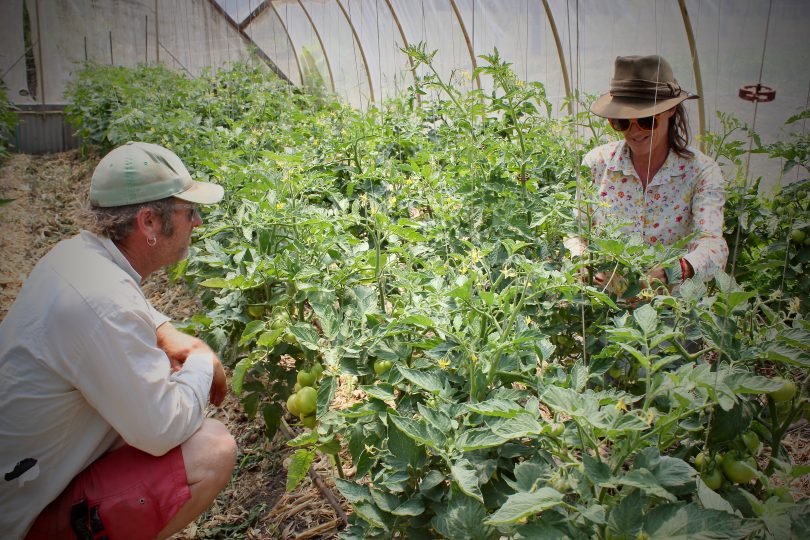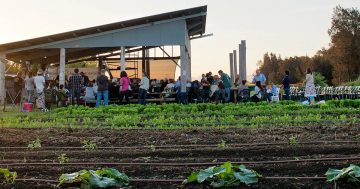
Fraser Bayley and Kirsti Wilkinson. Photo: Kat McCarthy.
Realising Eurobodalla’s potential for a thriving local food economy depends on three things beyond desperately needed rain – cognisance, culinary creativity and cutting old habits.
As bushfires force the intermittent closure of highways from Canberra and Sydney, regional communities are contemplating the drawbacks of a centralised food distribution system.
Fraser Bayley and Kirsti Wilkinson of Old Mill Road BioFarm say the Far South Coast’s climate and established community commerce networks offer not only solutions but opportunities.
“At the coast here, we have a fairly benign climate – it stays moister for longer,” Fraser says. “We can do seafood and oysters and dairy and vegies, plus beef and sheep. Everything apart from grain, although with extended dry periods we might be able to do that.”
The drought, exacerbated by a warming climate, is putting enormous pressure on farmers. Now, more than ever, individuals should consider the ‘energy quotient’ of food and consumables, Fraser says. Creating a local food economy can help communities move to where they need to be.
“Part of the reason we do this is because it’s a local solution to bigger problems,” Fraser says. “Everything has an energy quotient attached to it. If you have to pump water out of a river to service a hydroponic system (to grow a lettuce); build a power station to power it; pack that lettuce onto a truck and move it to the city; take it out of one warehouse and put it in another; then put it onto another truck to bring it down here – how much energy is that using?”

Old Mill Road BioFarm at Turlinjah, south of Moruya. Photo: Kat McCarthy.
Old Mill Road BioFarm at Turlinjah is a 65-acre family farm. The Tuesday afternoon SAGE Farmers Market in Moruya accounts for half of Fraser and Kirsti’s gross sales. They also deliver a weekly vegetable box from Tuross to Batemans Bay, sell to local restaurants, cafes and caterers and train market gardeners.
Fraser says greater demand for local products, via the SAGE market, local food businesses, greengrocers and butchers, would give newer farmers more freedom and security.
“Starter growers are struggling because of diversity and trying to keep everyone happy,” Fraser says. “If we could say to them – you just grow bok choi and silverbeet and Southlands Moruya will buy at this price point because they can move 200 bunches a week, – that’s a game-changer.”
Visiting city interns – who study Fraser and Kirsti’s regenerative techniques including holistic grazing management and increased pasture biodiversity – keenly observe SAGE projects and market, Kirsti says. They return home with ideas for boosting their own local food economies.
“People come here and ask – how do we get this community feel?” she says. “They go back and try to get more community involvement happening in their own town. The outer suburbs of Brisbane are really embracing local produce.”
To make the best use of local products, a creative, seasonal approach to cooking is needed, Fraser says.
“Supermarkets have created such a habit,” he says. “It’s the habit of buying the same thing every week; going up and down the aisle in the same pattern. Because you know where everything is and you can get the stuff you want. And you’re not forced to think – what the hell am I going to do with this cabbage? Again?”
Breaking long-held habits – and a stronger connection to our food sources – can be fulfilling in surprising ways, Kirsti says. “Every Monday, Fraser sends out a (customer) newsletter with a recipe tip. For our spring cabbages, he suggested (Japanese pancake) okonomiyaki. At the market, our customer came back and said – my husband just wants to live off this – he never comes to the markets but he’s here looking for cabbages!”
With a small-scale operation and deep dams on their property, Fraser and Kirsti are in a better position than many who are battling the drought. But in four weeks’ time, without rain – and with remaining water earmarked for livestock and bushfire threat – they’ll be forced to consider cutting back production.

Talking tomatoes – Fraser and Kirsti. Photo: Kat McCarthy.
SAGE Farmers Market Committee Chair Stuart Whitelaw says now is the time to think locally. “The highway closures show us that it doesn’t take much to throw this so-called centralised food distribution system into chaos,” he says. “It shows us how vulnerable we are and why need to think about a local food economy.”
Stuart says the most powerful way to support local farmers is simple: buy their products.
“We do have farmers down here who are hurting – not as much as people out west, but they’re still hurting,” Stuart says. “If you want to help our farmers, come to the markets. There may be hot and windy conditions some days, but our farmers are out there growing in those conditions. Now, more than ever, it’s vital that they have our support.”
Words by Kat McCarthy







